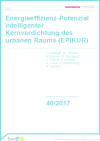Suchergebnisse für "Factsheet: Energietechnologien gestalten, die für alle sinnvoll und nutzbar sind"
Fachtagung: Kleinwindkrafttagung 2016
15. und 16. September 2016
Nach der erfolgreichen erstmaligen Durchführung 2015 findet die 2. Kleinwindkrafttagung unter dem Motto "Kleinwindkraft im Aufwind" in Wien statt.
Online-Symposium – Agile Digitalisierung im Baubetrieb
10. September 2021
Online
Auf Basis agiler und digitaler Methoden widmet sich das Symposium den Phasen der Planung, der Ausführung sowie dem Betrieb von Bauwerken. Aktuelle Entwicklungen sowie Best Practices werden aufgegriffen. Es sollen Anreize geschaffen werden, ressourcenschonend zu denken und zu handeln.
Energieeffizienz-Potenzial intelligenter Kernverdichtung des urbanen Raums (EPIKUR)

Das gegenständliche Forschungsvorhaben befasste sich mit den Möglichkeiten, Implikationen und Rückkopplungen, die sich durch eine "Stadterweiterung nach innen" mittels innerstädtischer urbaner Verdichtung ergeben. Dabei wurde Nachverdichtung als paradigmenfrei untersucht, d.h. unabhängig von bestehenden Regulativen, sondern anhand des vernünftig machbaren.
Schriftenreihe
40/2017
Herausgeber: BMVIT
Deutsch, 111 Seiten
Downloads zur Publikation
Expertenforum Energiespeicher Beton
8. November 2017, 14.00 Uhr
TU Campus Getreidemarkt, TUtheSky, Getreidemarkt 9, 1060 Wien, 11. OG
Aktuelle Forschungsergebnisse und Praxiserfahrungen zu hohen erneuerbaren Deckungsanteilen in Verbindung mit thermischer Bauteilaktivierung.
18. European Roundtable for Sustainable Consumption and Production
Die ERSCP findet von 1. - 5. Oktober 2017 in Skiathos Island, Griechenland statt. Das BMVIT und das StadtLabor in Graz laden zum Side event “Accelerating urban transition – how to integrate relevant stakeholders”. Interessante Beiträge können noch eingereicht werden.
SURO - Der städtische Untergrund als Rohstoffmine? Potential an Sekundärressourcen in der erdverlegten Infrastruktur
Machbarkeit eines Ressourcenkatasters zur Inventarisierung, Charakterisierung und Verortung der Materialbestände in den erdverlegten Infrastrukturnetzwerken österreichischer Stadtregionen. Das Ergebnis dient der ökonomischen Bewertung von Sekundärrohstoffpotenzialen.
Call for Papers – BauZ! Kongress 2022
BauZ! 2022 findet am 11. und 12. Mai statt. Thema ist das sanierte Gebäude als Teil seiner gleichfalls sanierten Umgebung. Reichen Sie ein: Ihr Beitrag kann die Präsentation eines Bauvorhabens, einer Produktentwicklung oder einer (abgeschlossenen) Forschungsarbeit sein. Einreichfrist verlängert bis 6. Februar 2022
Sonderausstellung „Erneuerbare Energien“ in der SONNENWELT Großschönau
30. März 2017
Sonnenwelt Großschönau, NÖ
Was haben erneuerbare Energien mit jeder/jedem Einzelnen zu tun? Diese Frage stand im Mittelpunkt der feierlichen Eröffnung der neuen Sonderausstellung in der SONNENWELT Großschönau zum Thema „Erneuerbare Energien“ am 30. März 2017.
P2PQ - Peer2Peer im Quartier
Das Projekt Peer2Peer im Quartier befasst sich mit der konkreten Umsetzung von Anwendungen zu Photovoltaik-Eigenverbrauchsoptimierung sowie Peer-to-Peer-Beziehungen auf Basis der Blockchain-Technologie in Quartieren und deren Validierung im Echtbetrieb.
IEA Vernetzungstreffen 2016: Urbane Energieinnovationen – Beitrag zur Energiewende
20. Oktober 2016, 09:00 - 17:00 Uhr
Modul, Peter Jordan Straße 78, 1190 Wien
Das IEA Vernetzungstreffen 2016 widmete sich dem Thema urbane Energieinnovationen und deren Beitrag zur Energiewende sowie den dafür relevanten Kooperationen in den IEA Technologieprogrammen.
Joint Call: "Integrated Regional Energy Systems" im Rahmen von ERA-Net Smart Energy Systems
ERA-Net Smart Energy Systems (SES) startet am 23. Mai 2018 den ersten Joint Call "Integrated Regional Energy Systems" für RDI Projekte (Ausschreibungsvolumen etwa 30 Mio Euro).
Programmevaluierung Haus der Zukunft 1999–2013
Um die wirtschaftlichen und technologischen Chancen Österreichs im Gebäudesektor zu erschließen wurde vom BMVIT (heute BMK) das Programm „Haus der Zukunft“ ins Leben gerufen. Dabei wurden in zwei Programmphasen ca. 450 Projekte mit einem Gesamtvolumen von € 138 Mio. mit knapp € 80 Mio. an Förderung unterstützt.
Kongress: e-nova 2019 - Nachhaltige Technologien
21. - 22. November 2019
Campus Pinkafeld
In drei parallelen Vortragsblöcken zu den Themen Energie, Gebäude und Umwelt werden aktuelle Forschungsergebnisse präsentiert und mit internationalen ExpertInnen diskutiert.
Stadt der Zukunft Themenworkshop "Urbane Energiesysteme"
15. Mai 2017
Hotel roomz Graz, Conrad-von-Hötzendorf-Straße 96, 8010 Graz
Aktuelle Projektergebnisse des Programms „Stadt der Zukunft“ wurden bei der Smart Energy Systems Week vorgestellt. Zur Intensivierung des Wissensaustauschs wurden nationale und europäische Netzwerkaktivitäten präsentiert.
Smart Communities and Technologies
17. Oktober 2016, 13:30 – 18:30 Uhr
TU Wien, 1040 Wien, Karlsplatz 13 (Hauptgebäude)
Im Rahmen der Veranstaltung „Blickpunkt Forschung“ präsentieren TUW-ForscherInnen und ihre Unternehmenspartner anwendungsnahe Projekte zu den zukunftweisenden Themen in zwei Parallelsesssions.
Kurzfilm: Österreichs größtes +Energie Bürohochhaus im Portrait
In zweijähriger Arbeit wurde das aus den 1960er Jahren stammende, ehemalige Chemie-Hochhaus der TU Wien zu Österreichs größtem Plus-Energie-Bürohochhaus umgebaut und 2014 eröffnet. Der aktuelle Kurzfilm beschreibt das nach wie vor zukunftsweisende Projekt.
Smart Cities Demo 2020 – Boosting Urban Innovation
Thematischer Schwerpunkt der heurigen Ausschreibung ist urbane Resilienz v.a. im Lichte des Klimawandels. "Smart Cities Demo" ist ein Programm des Klima- und Energiefonds der österreichischen Bundesregierung. Einreichschluss ist der 20. Oktober 2020.
Unterstützungsmaßnahmen zur Technologieinternationalisierung
6. September 2016
Oesterreichische Kontrollbank, Reitersaal
Vorstellung der Förderungsprogramme kit4market und tec4market
Zertifizierung von Siedlungen / Quartieren
Sondierungsprojekt zur Übertragbarkeit des Schweizer Systems der 2000-Watt Arealbewertung auf Österreich
Eröffnung von Österreichs erstem Cradle-to-Cradle inspiriertem Plusenergiegebäude
Am 8. September 2017 wurde mit einem großen Fest die neu errichtete Druckhalle von gugler* in Pielach bei Melk eröffnet, die umfassenden Standards der Nachhaltigkeit gerecht wird.
